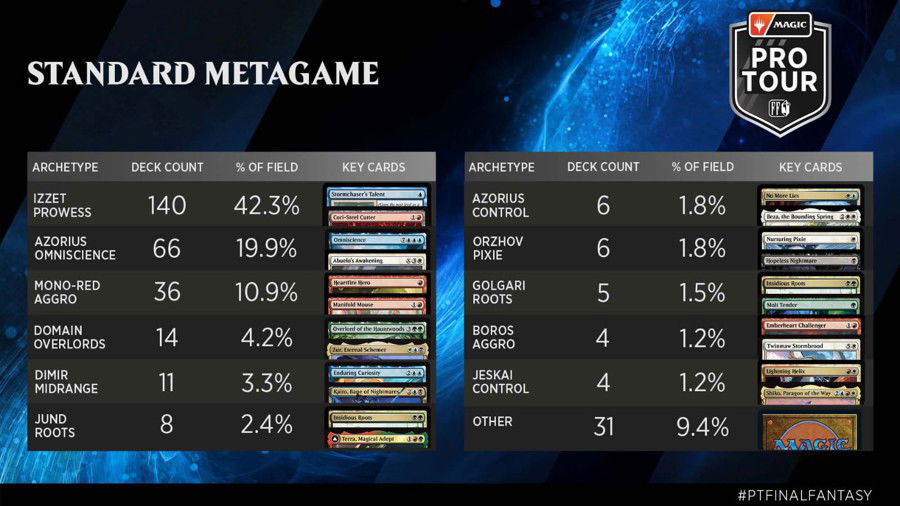It's been a while since Pioneer has been at the center of social media discourse about Magic: The Gathering. Distant from the spotlight due to the lack of competitive events during 2025, the format has been in a crisis where even its longevity is in doubt: if it weren't for the recent naming of the format change from Magic Arena's Explorer to Pioneer, it would be plausible to consider that Wizards of the Coast is not even paying attention to the format's events, much less its Metagame.
With the next Banned and Restricted announcement scheduled for June 30, most of the community expects Standard to undergo major changes: Monstrous Rage. Up the Beanstalk, Cori-Steel Cutter and This Town Ain't Big Enough are some of the most discussed cards around banning.
The same could perhaps be said about Pioneer — Red Aggro is the best deck in the format today and has caused changes and adaptations in the Metagame as a whole, and while Challenges show that there is still room for innovation (we are seeing Orzhov Greasefang grow, just as we saw Boros Monument become a deck last season), three decks usually represent almost 50% of these events: Red Aggro, Izzet Phoenix and Mono Black Midrange.
So, has the time come to adjust Pioneer? Would we be willing, or is it really necessary to go through radical changes in the Metagame at this point? Would this be a starting point to revitalize the format again?
Pioneer, Standard, and the power creep relationship
How did we get here? I mean, can you imagine a time in history when Mono Red Aggro seemed too strong in any other situation in competitive Magic? The last time we saw any discourse was during the Goblin Chainwhirler era of Standard, where one card was essentially invalidating every X/1 creature in the Metagame—yet Chainwhirler went the entire season untouched.
Last year, the idea that Mono Red or Prowess could be truly good in Pioneer seemed absurd. For several months, we were in a spot where Amalia Benavides Aguirre and Vein Ripper basically locked the Metagame—it was becoming increasingly clear that Pioneer needed fixing… again: we went through the same problem with Karn, the Great Creator, with Thassa’s Oracle, and it’s been like this over and over since the format was born.
The community has had this discussion a dozen times in the past, but it’s worth noting that we got to this point because new cards are gradually getting stronger. It's power creep: a natural tool in every game where, eventually, new, more efficient cards come out and replace less versatile old cards.
The problem is how this case applies to Pioneer: except for some naturally overpowered pieces — Fatal Push, Thoughtseize, Treasure Cruise —, the format lives in the middle ground between when Magic was more restrained and avoided putting overpowered cards in a single set so as not to create problems in eternal formats, the F.I.R.E. era, which gave birth to cards like Oko, Thief of Crowns and Teferi, Time Raveler, and the current era that, despite not having a proper name, I call the “era of efficiency”: everything has an ETB, everything costs less and leaves something permanent on the board, everything is a power play or has an absurd synergy with X, Y or Z.

Did Monstrous Rage really need to give permanent Trample? Can Sunspine Lynx really do all of this and still have a super-efficient body for its cost? Does it make sense for Screaming Nemesis to have an ability that affects the opponent for the rest of the game?

This is the opposite of the mice package. Yes, they are wonderful together, and I'm a proponent of banning Heartfire Hero in Standard as a solution to slowing down the format. But they're just a set of cards that work well together, rather than being hyperefficient. Anything that breaks them is more of a cause-and-effect relationship (Monstrous Rage with Manifold Mouse) than intentional design.

Somehow, everything today feels a little too close to the effectiveness of cards like Fable of the Mirror-Breaker than it should. And the result is a constant increase in new decks and new cards entering the top of the Metagame and/or making predefined staples obsolete. Combined with the lack of adequate answers, we've ended up in a situation where we have great threats from 2025 and still try to answer them with Fatal Push from 2016.

There is, however, an advantage to this philosophy: Pioneer needs Standard, and Standard technically needs Pioneer. Think about the Rakdos/Grixis/Esper Midrange players from last season. In addition to the bans they faced, most of their cards fell out with the previous rotation: Bloodtithe Harvester, Wedding Announcement, The Wandering Emperor, the Triomes… They needed a place for their cards, and Pioneer was that place — similarly, if you're playing Cori-Steel Cutter today, and it's likely to be banned on June 30th, you might find a solution for your Prowess decks in Pioneer.
Pioneer is, and needs to be, the place where Standard players can enjoy the cards which rotate. This will be even more important with Universes Beyond, where a Final Fantasy fan, for example, can lose their cards in three years and migrate to another format to enjoy decks with their favorite characters.
Having more impactful cards showing up more often in the format naturally means giving these decks more space in the competitive environment of a non-rotating format, but the consequence is the same as we see in Modern: when there is more power creep, the format “rotates” anyway. Do you remember Bonecrusher Giant? Or maybe Knight-Errant of Eos and Boros Convoke? What happened to Nykthos, Shrine to Nyx in the last few months?

Despite this, there are pillars that remain in the format. Izzet Phoenix has been around since Pioneer was born, Black-Based Midrange changes between Mono Black or Rakdos but remains basically the same, Azorius Control gains new tools but remains with Teferi, Hero of Dominaria and is still one of the best decks, and a dozen other established archetypes (Sacrifice, Spirits, Angels, Ensoul) remain in Tiers 1.5 despite the addition of new tools — even with power creep, Pioneer remains relatively stable.
What if stable means boring?
At this point, Pioneer has been somewhat forgotten by content creators and pro players. In the past, there was constant criticism that the format should even be replaced by Modern in RCQs (as happened in 2025) because it was “too stale and boring”.
The complaints were around the time of Vein Ripper and Abzan Amalia, but they also happened when Nykthos Ramp was the best deck, or when Rakdos Midrange was at the top, or with Izzet Phoenix — the consumption pattern of Magic and card games has changed to “we always want something new”, which also means “we always want innovative Metagames”, and you can't have innovation with a stagnant format.
It's common in human nature to justify certain things by external factors. We're conditioned to think that all our glories are due to merit, and our setbacks are the responsibility of something bigger that doesn't specifically involve our decisions — and, yes, that involves Magic too.

Consider, for example, the Pro Tour Final Fantasy Metagame. Statistically speaking, it’s pretty clear that Izzet Prowess is the best deck in Standard — consequently, more people play it. With more people playing it, the less archetype diversity we have in the format because, after all, if we want to win, we play the deck that wins.
Now, apply this logic to any format: outside of decisions based on play style or financial factors, why would you go to a tournament with anything other than the deck that wins the most? And with such a low sample size compared to other formats like Pioneer has today — it's one of the least-played formats in Magic Arena, and with the lack of RCQs, there's no reason to explore it much — the result is even more obvious: those who want to earn some points in Challenges will just pick the best deck and move on.
And yet, Pioneer has plenty of room for innovation. Recently, Greasefang, Okiba Boss lists have been running Monument to Endurance for a new Orzhov version. Mono Black Midrange has adopted Cecil, Dark Knight and Dark Confidant for a more mana-efficient variant, Mardu Humans has gone 5-0 in Leagues using various Final Fantasy legends, and even the most well-established archetypes have been slowly transforming.
It's not like the format is stuck in the same place. There is little reason to innovate in it when there is no competitive scene to encourage players to look outside the box. To think of innovative ways to use new and old cards, and even in those cases, it is natural for some archetypes to maintain the status quo, for better or worse.
Pioneer and the June 30th Banlist
The first point to consider is whether the format needs a ban now. And the answer will be quite divided among the community, depending on who you ask: even Thoughtseize — the format's main regulatory tool — has already had calls for bans on social media.
If we look at the numbers, there are three archetypes showing possible warning signs: Mono Red Aggro, the ever-present Izzet Phoenix and Black Midrange (today Mono Black, if it weren't for Sunspine Lynx, it would be Rakdos). Like many changes in non-rotating formats, if we take away one piece, we reinforce others.

The best example is Sunspine Lynx. It limited the possibility of unrestricted two-color mana bases in Pioneer and became the closest we've ever had to Blood Moon or Price of Progress in the format — tools that, by nature, players were not used to dealing with. Thus was born Mono Black Midrange, the rise of Selesnya Angels, and even Spirits reappeared to combat these strategies.
Banning Sunspine Lynx means bringing Rakdos Demons back to the top. Decks like Zur Overlords might have more success, but the main beneficiary of this intervention is the archetype that is already naturally good in the format, and would simply return to its more effective two-color version.

Monstrous Rage, just like in Standard, punishes blocking and benefits cards with Prowess, the mice package, and now it becomes an improved Dark Ritual with Vivi Ornitier, which still hasn't done enough in Pioneer outside of Lotus Combo. Removing it means slowing down the format and opening up more windows for potential blockers and trades in combat — in practical terms, you enable other Aggro because Mono Red is no longer the one that "plays under those who play under".

Year after year, we always come back to talking about Treasure Cruise. The spell is banned from other formats in which it is legal for a reason, but it remains in Pioneer as one of the format's "charms". This charm has some costs to consider in deckbuilding concessions, but anyTurbo Xerox archetype benefits from it.
This brings us to an interesting case:

Would Arclight Phoenix be too good for Pioneer? When the format was born, the archetype was based solely on this card and had Crackling Drake as an alternative threat. Now, we have Cori-Steel Cutter to complement this game plan, and before that, Proft’s Eidetic Memory’s interaction with any creature already created a solid backup plan for the archetype.
The biggest problem with Arclight Phoenix is that they are difficult to deal with without the right tools and its deck plays too well around hate, while having the most comprehensive sideboard in the format. It does a lot for a single deck, and perhaps removing the main line of recurring threats would be a way to create other lines that are more easily answered.

This line, however, would involve Cori-Steel Cutter, and this could be as troublesome a card as Phoenix in snowballing the opponent and always ensuring a threat on the board. In practice, Cori-Steel Cutter would be as damaging or more than Arclight Phoenix in a dedicated deck, and as we're seeing in Standard, it's very difficult to counter and also attacks from many fronts with ease.

We also have the elephants in the room that we don't discuss anymore: Unholy Annex with Mutavault is too efficient at extracting value and draining the opponent's life for a low cost, and there's little to no effort in prolonging the game to the point where the demon token wins the game. A Phyrexian Arena with benefits does a bit too much, and served to further solidify a deck that was already at the top before Duskmourn.

Finally, Fable of the Mirror-Breaker remains one of the strongest individual cards in Pioneer. It does a lot for its cost, and the only reason it's down today is that the two-color decks that used to benefit from it are being held back by Red Aggro and Sunspine Lynx.
What could be banned on June 30th?

If the plan is to shake up Pioneer a bit and just give the Metagame a bit more diversity, we want to remove Monstrous Rage. Many archetypes are crippled by Red Aggro's ability to play too under, including other Aggro. And as long as it remains that effective, the archetypes that could technically hold back Midranges are also unable to hold its clock.

Another possibility is to entirely change the Pioneer metagame, taking advantage of its low attendance to make surgical changes while people are not buying many cards to play at tournament tables.
In this case, we want to affect the main decks to open up space for new strategies, and there are a few possible lines in this scenario: Monstrous Rage would come out anyway because Sunspine Lynx plays an important role in holding down greedy mana bases, and four mana is enough time to have a decent answer against it.
Unholy Annex, as we mentioned, does a lot for its cost and interacts too well with Mutavault. Removing Mutavault is counterintuitive since it hurts several type-base archetypes because of one card, so it would be easier to deal with the enchantment and let the Midranges redefine themselves with Dark Confidant and the like.
The case of Izzet Phoenix is complex. At this point, I would even consider banning Arclight Phoenix, but Cori-Steel Cutter is a card that is more universally played in other decks and is far too efficient for its cost. Even if we removed Phoenix, we could most likely simply turn it into a Cutter deck and have similar results.
However, simply removing Cori-Steel would mean returning Phoenix to its former shell and remaining at the top of the Metagame, perhaps as a deck that is still too restrictive. Treasure Cruise is still one of the best cards in Pioneer, and we have too many cheap tools to get the most out of it, so it would make sense to remove one of the archetype’s ways to recover your hand and still interact with Proft’s Eidetic Memory — an advantage that Dig Through Time does not offer.
Wrapping Up
That’s all for today!
If you have any questions, feel free to leave a comment!
Thanks for reading!













— Comments 0
, Reactions 1
Be the first to comment